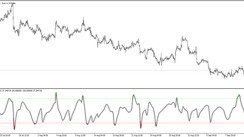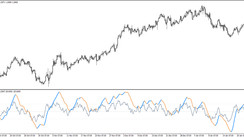A recent 2% decline in oil prices to a week-long trough last Thursday underlines the tumultuous climate in the oil market, largely driven by the U.S.'s political deadlock over the debt ceiling. This situation has sparked fears of a potential recession in the world's top oil-consuming nation. Compounding these concerns were the increasing U.S. unemployment claims and subdued Chinese economic figures.
In the crude oil market, Brent futures dropped $1.43 or 1.9%, settling at $74.98 per barrel. Similarly, West Texas Intermediate crude (WTI) slid down $1.69 or 2.3%, ending the day at $70.87 per barrel. For both benchmarks, these marked their lowest closing points since May 4.
The U.S. dollar climbed to its highest level since May 1 against a selection of major currencies. This surge was spurred by recent U.S. jobless claims statistics, reinforcing the Federal Reserve's decision to pause interest rate hikes, though without suggesting potential rate cuts by year-end.
A thriving dollar tends to make oil pricier for other nations. Moreover, increased interest rates could hinder oil demand by escalating borrowing costs and straining economic growth.
In a plea to Congress, U.S. Treasury Secretary Janet Yellen advocated for an increase in the $31.4 trillion federal debt ceiling to sidestep an unparalleled default that could catalyze a global economic recession.
Energy consulting firm Ritterbusch and Associates highlighted in a note, "Persistent uncertainties surrounding the U.S. debt ceiling, recent banking hiccups potentially causing a wide-reaching credit crunch in the oil industry, and the sustained threat of a recession remain as formidable challenges for the oil markets."
Repercussions of Escalating Borrowing Costs and Dwindling Demand
Adding to the downward pressure on oil prices, the U.S. Dow and S&P 500 indices dipped following recent turbulence at California-based bank PacWest Bancorp, which triggered another meltdown in the regional banking sector.
Neel Kashkari, Minneapolis Federal Reserve President, noted that an enduring era of high interest rates could intensify stress on banks, but may be required if inflation remains persistently high.
The U.S. witnessed a modest rise in producer prices last month, marking the smallest yearly producer inflation surge in over two years.
Elsewhere in the U.S., the Biden administration rolled out a comprehensive plan aimed at significantly reducing greenhouse gas emissions from the power sector. This initiative is one of the most substantial efforts to date towards decarbonizing the economy in response to climate change.
In China, new bank loans in April fell considerably more than anticipated, stoking concerns that the country's economic rebound post-pandemic is slowing down.
"Following another round of Chinese data, specifically monetary metrics, it's clear that China's economic recovery from the pandemic continues to underperform," observed Edward Moya, senior market analyst at data and analytics firm OANDA.
The oil market largely overlooked OPEC's global oil demand forecast for 2023, which estimated an uptick in demand from China, the world's largest oil importer. OPEC predicted a 800,000 barrels per day (bpd) increase in Chinese oil demand, a considerable rise from its previous estimate of 760,000 bpd. However, OPEC cautioned that this surge could be counterbalanced by economic risks elsewhere, such as the ongoing U.S. debt ceiling dispute.
On the supply front, Iraq has approached Turkey with an official request to reinitiate oil exports via a pipeline traversing from the semi-autonomous Kurdistan Region in northern Iraq to the Turkish port of Ceyhan. This development could potentially introduce an additional 450,000 bpd into global crude oil movements.
This cocktail of geopolitical tensions, economic concerns, and fluctuating dollar values continues to cast a shadow over the oil industry. Amid these uncertain times, stakeholders are keenly watching these developments, underscoring the interconnectedness of the global economy and the oil market.
Market analysts and investors are closely monitoring the situation, particularly how the U.S. navigates its debt ceiling standoff and how China maneuvers its economic recovery. The outcomes of these scenarios will undoubtedly have profound implications on the future trajectory of the oil market.
In conclusion, the myriad of complexities in the current geopolitical and economic landscape underscores the need for a vigilant eye on the global oil market. As nations grapple with internal and external pressures, the ripple effects are felt across the global economy, especially in industries as pivotal as oil. As we move forward, the world will continue to watch and wait, anticipating the next major development that could tip the scales in this intricate dance of supply and demand.
BofA's Revised Global Oil Consumption Growth Expectations, Trims Price Forecast to $80
The cocktail of escalating borrowing costs, dwindling demand, and the ongoing U.S. debt ceiling conflict has spurred Bank of America to revise its 2023 Brent crude oil prediction on Tuesday.
The bank now anticipates a price of $80 per barrel, a 9% reduction from its former prediction of $88 per barrel. However, this new projection still signifies a 5% increase from present figures.
"Monetary factors are pulling Brent crude prices downwards," expressed Francisco Blanch, the chief of BofA's global commodities research division, in a report. Brent crude achieved its annual peak above $88 per barrel in late January.
He further elaborated, "As central banks persist in overcompensating for their previous policy error (high inflation), oil is hastening to foresee disinflation and a U.S. recession triggered by banking collapses and restrictive lending conditions."
Blanch also highlighted that the escalating debt ceiling dispute could amplify these macroeconomic headwinds. He pointed out that the premium for insuring against a U.S. debt default recently reached its peak since 2009.
On Tuesday, President Joe Biden convened with Congressional leaders to negotiate a solution to avert a potential debt default.
The U.S. government may exhaust its funds as early as June 1, necessitating a split Congress to elevate the nation's $31 trillion debt ceiling promptly or risk pushing the U.S. into a disastrous and unprecedented debt default that could initiate a recession.
Anticipated Fluctuations in OECD Oil Demand
The Federal Reserve's rapidly climbing interest rates and a contraction in credit availability to businesses and households have already started to pare back oil demand. Consequently, BofA has downgraded its global oil consumption growth estimates to 1.2 million barrels of oil per day for this year and to 1 million barrels for the next.
Despite the downward revisions for 2023, the investment bank maintains its Brent price forecast of $90 for 2024. This expectation arises from the potential for OPEC and its allies to cut production once more in a bid to safeguard prices. In April, OPEC announced it would reduce production by 1 million barrels per day.
Blanch expressed his belief that "OECD demand will eventually recover, while OPEC+ will likely continue to actively and preemptively regulate supply."
The Organisation for Economic Co-operation and Development anticipates a contraction in oil demand by 400,000 barrels per day this year and by 200,000 million barrels per day in 2024.





